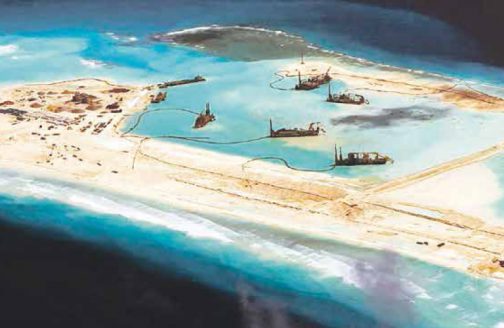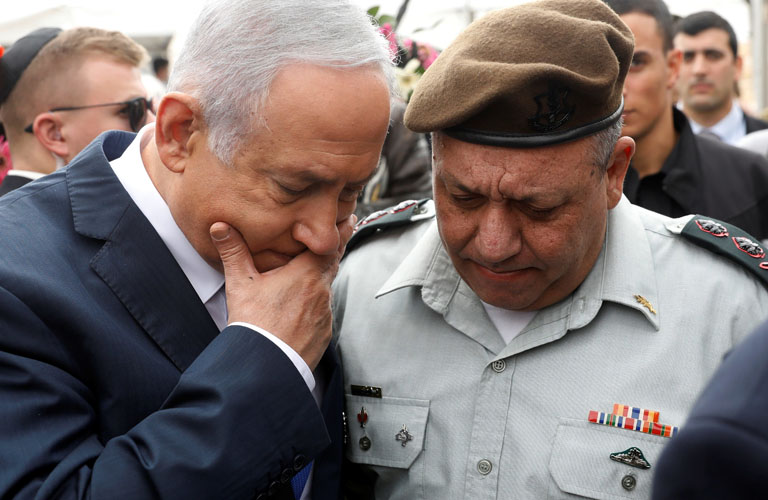The Trump administration adds uncertainty to the standoff in the South China Sea

A new phase of strategic uncertainty has emerged in relations between China and the United States under the Trump administration on a number of issues, including maritime security in the South China Sea. Rising tensions create the prospect of a downturn in bilateral relations or, worse, a confrontation at sea or in the air over contested waters.
A review of the four major developments in the South China Sea in 2016 is instructive, as they form the context for the Trump administration as it manages its relations with Beijing.
- In September of the past year, President Xi Jinping stated at a joint press conference with President Barack Obama at the White House that China would not militarize its artificial islands. Nonetheless, China has continued to consolidate its military presence in defiance of an Arbitral Tribunal ruling that China’s Nine-Dash Line claim to the South China Sea had no foundation in international law.
In 2016, China not only completed the construction of three 3-kilometer-long runways on Fiery Cross, Subi and Mischief reefs; it also built reinforced hangars with space to accommodate 24 fighters and three to four larger planes (such as bombers and aerial tankers) on each reef. China later added point defenses on all of its facilities housing antiaircraft guns and surface-to-air missiles. - The Obama administration successfully deterred China from building an artificial island and airfield at Scarborough Shoal in an unprecedented orchestration of military power and high-level diplomacy. In March 2016, American defense officials reported unusual Chinese surveying activity around Scarborough Shoal. US and Australian intelligence and analytical agencies later warned that China was poised to take “decisive and provocative action,” such as the construction of a fourth airfield.
A Chinese airfield on Scarborough Shoal would complete the triangle linking Woody Island in the Paracels with occupied features in the Spratly Islands and give China the ability to monitor virtually all aircraft and surface ships passing over or through the South China Sea.
Obama reportedly raised this issue in a candid exchange with President Xi on the sidelines of the nuclear security summit in Washington in March.
In April, the US conducted at least three aerial patrols around Scarborough Shoal using A-10 Thunderbolt ground attack aircraft based in the Philippines. The USS John C. Stennis aircraft carrier strike group returned to the South China Sea and the US and the Philippines announced the commencement of joint naval patrols.
In June, the USS Ronald Reagan aircraft carrier replaced the Stennis on patrol duties and the US deployed four EA-18 Growlers, the world’s most advanced electronic warfare aircraft, to the Philippines. During the summer, three US destroyers conducted independent patrols in the waters around the Spratly Islands and two carrier strike groups, Stennis and Reagan, along with six warships conducted a large-scale exercise off the east coast of the Philippines. - In 2016, the US Navy conducted three Freedom of Navigation Operational Patrols (FONOP). In late January, the USS Curtis Wilbur cruised by Triton Island in the Paracels; in May, the USS William P. Lawrence passed near Fiery Cross Reef; and in October, the USS Decatur returned to the waters near Triton. China responded to the first FONOP by deploying J-11 fighters and surface-to-air missiles to Woody Island.
China responded to US military activities in the South China Sea by regularly shadowing and challenging US Navy warships and maritime reconnaissance aircraft, and by conducting combat air patrols, including nuclear capable bombers, over the South China Sea. In December, Chinese sailors seized and later returned a US underwater drone. - Vietnam responded to China’s militarization of the Spratly Islands. During the first half of the year Vietnam reportedly placed Extended Range Artillery rocket launchers on five of its features in the Spratlys. Vietnam also extended the length of its airfield on Truong Sa Lon Island, reportedly to deploy maritime patrol aircraft.
In contrast, the Philippines, under the new administration of Rodrigo Duterte, took a number of actions that undermined the close military cooperation with the US established under the Aquino administration. Duterte terminated joint patrols with the United States and lurched to embrace China. Duterte’s actions threaten to undermine the US-Philippines Mutual Defense Treaty. Duterte’s opening towards China gives Beijing every incentive to downplay its military assertiveness in favor of diplomacy.
The election of US President Donald Trump has raised the level of strategic uncertainty between China and the United States.
During the presidential election campaign, Trump repeatedly called Beijing a currency manipulator and threatened to slap higher tariffs on goods imported from China. If Trump follows through, a trade war could erupt. Trump also tweeted criticism of China’s island-building in the South China Sea.
On Dec. 2, President-elect Trump took a telephone call from Tsai Ing-wen, the president of the Republic of China on Taiwan. Trump’s action marked the first time in 36 years that a US president or president-elect had spoken to the government leader of Taiwan.
On Dec. 8, China dispatched its only aircraft carrier, the Liaoning, to sail in the waters off Taiwan in a pointed response to Trump’s telephone call with President Tsai. China also deployed a Xian H-6 nuclear-capable bomber on a patrol around China’s Nine-Dash Line claim to the South China Sea.
After China criticized his telephone conversations, Trump tweeted: “Did China ask us if it was OK… to build a massive military complex in the middle of the South China Sea? I don’t think so!” In an interview with The Wall Street Journal on Dec. 4, Trump was asked whether he supported the One-China policy, Trump replied: “Everything is under negotiation, including One-China.”
While Trump’s tweets and comments raised the temperature in Beijing-Washington relations, they paled by comparison to the furor that followed comments by Rex Tillerson, Trump’s then nominee for secretary of state, at his confirmation hearing before the Senate Foreign Relations Committee on Jan. 11.
During his testimony, Tillerson called China’s construction and militarization of artificial islands in the South China Sea “akin to Russia’s taking Crimea” from the Ukraine. When Tillerson was asked whether he supported a more aggressive posture against China, he responded: “We’re going to have to send China a clear signal that, first, the islandbuilding stops and, second, your [China’s] access to those islands also is not going to be allowed.”
Tillerson characterized China’s construction of artificial islands in the South China Sea as “extremely worrisome,” for if China were able to dictate access to the South China Sea, it would threaten the “entire global economy.” He used the term “illegal actions” to brand China’s island-building in the South China Sea and its declaration of an Air Defense Identification Zone in the East China Sea. “The way we’ve got to deal with this,” he concluded, “is we’ve got to show back up in the region with our traditional allies in Southeast Asia.”
Tillerson’s comments added another pressure point to Sino- American relations that are already strained. This was immediately evident when the hawkish Chinese Global Times shot back: “Tillerson had better bone up on nuclear power strategies if he wants to force a big nuclear power to withdraw from its own territories. […] If Trump’s diplomatic team shapes future Sino-US ties as it is doing now, the two sides had better prepare for a military clash.”
On Jan. 20, White House spokesperson Sean Spicer was asked at a press conference whether Trump agreed with Tillerson’s comments. Spicer replied: “I think the US is going to make sure that we protect out interests there [in the South China Sea]. It’s a question of if those islands are in fact in international waters and not part of China proper, then yeah, we’re going to make sure that we defend international territories from being taken over by one country.” China’s state media immediately retorted that the United States would need to “wage war” to stop China from accessing its sovereign territory.
In its first days in office the Trump administration has created strategic uncertainty among allies and foes over US policy towards China and raised the possibility of a confrontation in the South China Sea. The Obama administration has been widely viewed by its critics as being weak in response to Chinese militarization of the South China waters. It remains to be seen if the remarks by Trump and his top officials are to be taken as the first building blocks of a new and more assertive US policy toward China, or if they are merely the opening gambit to extract trade concessions from Beijing.
A version of this article appeared in print in February, 2017, with the headline “Chinese takeout ”.
Carlyle A. Thayer is emeritus professor for the University of New South Wales at the Australian Defence Force Academy, Canberra.



